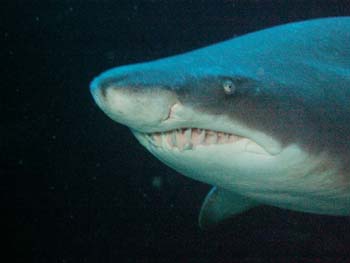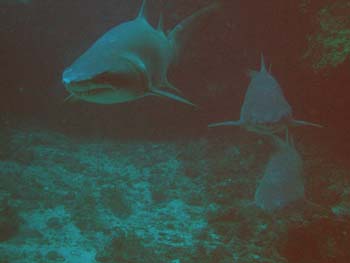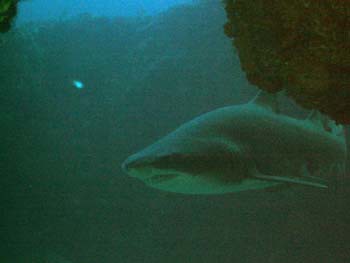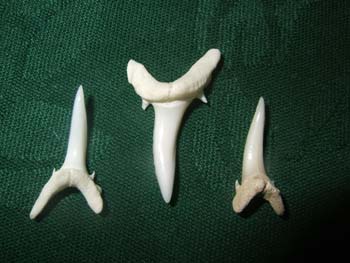 As they are quite slow moving it is possible to dive with them in a number of locations fairly easily such as the wrecks off the coast of Carolina or the east coast of Australia where they are critically endangered. I took these pictures on Protea Banks off the coast of Kwa-Zulu Natal last year.
As they are quite slow moving it is possible to dive with them in a number of locations fairly easily such as the wrecks off the coast of Carolina or the east coast of Australia where they are critically endangered. I took these pictures on Protea Banks off the coast of Kwa-Zulu Natal last year.  If you are not a diver you may still be able to see them as they are popular public aquarium subjects due to their fearsome looks and ability to pump water over their gills unlike many sharks. Captive breeding happily does occur (and is looking increasingly significant for the Australian population). These sharks are slow to reproduce as the foetuses eat each other in the womb and so only one or two youg are birthed by each female per pregnancy.
If you are not a diver you may still be able to see them as they are popular public aquarium subjects due to their fearsome looks and ability to pump water over their gills unlike many sharks. Captive breeding happily does occur (and is looking increasingly significant for the Australian population). These sharks are slow to reproduce as the foetuses eat each other in the womb and so only one or two youg are birthed by each female per pregnancy.
As these sharks tend to return to hang out in the same caves, gullies and wrecks year after year in groups you can frequently find old teeth lying on the floor beneath the sharks.

Many species of shark are threatened by the trade in shark fins to make shark fin soup. Although the fin doesn't add to the taste of the soup it is seen as a sign of affluence to have the fins. This trade is particularly distasteful as the rest of the shark is often thrown back in to the water to rot so the boats in question can fit more fins on the boat. We can help support conservation of sharks and othe pelagic species by supporting organisations such as Sharklife ( http://www.sharklife.co.za/ ), Bite-back (http://www.bite-back.com/) and the Shark Trust (http://www.sharktrust.org/sharkconservation.html ).
No comments:
Post a Comment